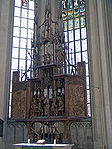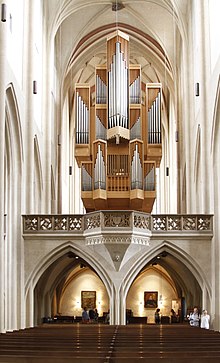City Church St. Jakob (Rothenburg ob der Tauber)
The Evangelical Lutheran parish church of St. Jakob in Rothenburg ob der Tauber was built between 1311 and 1484 . The east choir was completed in 1322, after a break in construction the main nave was built between 1373 and 1436. The west choir spanning a street with the Holy Blood Chapel was built between 1453 and 1471. The consecration took place in 1485. In 1544 the Reformation was introduced. The church was extensively renovated between 2005 and 2011. The cost of the entire project is around 9 million euros.
What is striking about the Gothic church, which looks simple from the outside, is that it has two towers of different heights (south tower: 55.2 m, north tower 57.7 m). The tracery windows of the east choir are adorned with valuable paintings, the oldest dating from 1350 and others from 1400.
Altars
Holy Blood Altar
In the west gallery of this church is the famous Holy Blood reredos by the Würzburg carver Tilman Riemenschneider , which he carved between 1500 and 1505 for a Holy Blood relic . This relic is in conversation Enge kept in a rock crystal capsule of relics Cross (ca. 1270). The Holy Blood relic is said to be a drop spilled from the chalice during the Lord's Supper, which became the blood of Christ through the change .
In 1499 the housing was commissioned from Erhart Harschner by the Rothenburg City Council . The contract with Riemenschneider for the sculptural decoration is dated April 15, 1501. On May 8, 1502, the shrine was erected in the west choir of St. James' Church together with the reliquary cross. The figures were supplemented by January 1505.
The themes of the figurative design are Jesus' entry into Jerusalem (heraldic right wing), the Lord's Supper (shrine) and the Mount of Olives (heraldic left wing). Not only the grandiose carving technique of the master was innovative, but also the monochrome version and the design of the retable as a permanent, unchangeable showpiece (the wings are not designed on the weekday pages). The openwork shrine and the refined relief work are combined with a revolutionary light dramaturgy that was not known before.
The central figure is Judas, not, as is usually the case, Jesus himself. Judas and Jesus also have an astonishing similarity in facial features. The figure of Judas can be removed from the picture and covers the gap between the two relief blocks of the shrine. Only when the figure of Judas is removed does the apostle John behind it become fully visible; he has laid his head on his arms and is sleeping.
Twelve Messengers Altar
The main altar of the church is the Twelve Messenger Altar from 1466. The late Gothic winged altar contains a carved group of crucifixions and saints and is located in the east choir of the church. In addition to the wings and the predella , the altar is painted on the outside and the back. The pictures on the altar are by Friedrich Herlin , the sculptural works are probably from the Ulm School under the influence of Hans Multscher . The altar body was made by the carpenter Hans Waidenlich , who, together with Herlin, had already created the high altar of St. George's Church in Nördlingen in 1462 . On the back of the side wing (working day side) you can see the oldest depiction of the city of Rothenburg ob der Tauber and very rare legends of the pilgrims of St. James , which are related to the legend of St. James . The execution follows the pattern of the Nördlinger Altar, which was probably designed by Nikolaus Eseler the Elder .
The good condition of the interior of the altar is probably also due to the fact that it was kept closed for a long time after the Reformation . Since the now visible representations of St. James appeared too Catholic, they were painted over with scenes of the Passion of Christ by the painter Martin Greulich in 1582 . Only the two backgrounds of the two middle pictures, one of which shows the Rothenburg market square, remained untouched. The paintings were restored in 1922 and returned to their original condition.
More altars
Further gems in the church are the Ludwig von Toulouse altar by Tilman Riemenschneider with wings attributed to Jakob Mülholzer and the Maria Coronation altar (with sculptures from different centuries, including the Riemenschneider school).
organ
The great organ of St. Jakob was built in 1968 by Rieger Orgelbau (Vorarlberg) and has 69 registers with around 5,500 pipes . The organ has two sides of the prospectus and has two console tables : a four-manual main console on the front and a two-manual secondary console (to which the swell and chest and five separate pedal stops in Pedal Work II are assigned). The Spieltrakturen are mechanical ( abrasive loading ; cone loading in the large octave of the pedal), the key action is electric. A comprehensive renovation and cleaning of the organ was planned for 2019/2020, including adding a new setting system and (in addition to the existing mechanical coupling ) electrical coupling. The disposition :
|
|
|
|
|
||||||||||||||||||||||||||||||||||||||||||||||||||||||||||||||||||||||||||||||||||||||||||||||||||||||||||||||||||||||||||||||||||||||||||||||||||||||||||||||||||||||||||||||||||||||||||||||||||||||||||||||||||||||||||||||||||||||||||||
- Coupling in the main gaming table: III / I, I / II, III / II, IV / II, I / P, II / P, III / P.
- Playing aids in the main game table: 8 mechanical combinations (star setters). Swell kicks for swell and breastwork. Push button: Tongues off, register fetter , tutti, glockenspiel, damper, Zimbelstern, gaming table below off.
- Coupling in the side table: II / I, I / P, II / P.
- Playing aids in the secondary table: 6 mechanical combinations (star setters). Swell kicks for swell and breastwork. Push button: Tongues off, gaming table above off. Steps: hand register off, pleno.
- Remarks:
- ↑ a b c Horizontal, in the front brochure.
- ↑ Range: C – f 3 ; is located in the swell.
- ↑ a b c d Added after 1968.
- ↑ a b c in the rear prospectus.
- ↑ Can only be played from the lower side table. The pipework is located on the back in the two side cases above the side table.
- ↑ + 1 1 ⁄ 3 '.
Bells
The church has a precious six-part bell that is distributed across both towers. All bells were cast on site in 1626 by the Lorraine traveling bell caster Petrus Bulevilius and Caspar Delson. These are the weather bell (cis'), the night and gate bell (d '), the sermon bell (e'), the noon and hearing bell (g '), the death bell (h') and the vesper bell (cis " ).
|
No. |
Surname |
Mass (kg, approx.) |
Ø (mm) |
Percussive ( HT - 1 / 16 ) |
inscription |
tower |
|---|---|---|---|---|---|---|
| 1 | Weather bell or: big bell |
1,800 | 1400 | cis 1 | FUSA ROTENMBURGI CAMPANA EST! PONDERE SUMPTU AERE SONO RELIQUIAS, EXUPERANSQUE NOLAS.ANO DNI MDCXXVI MENSE SEPTEMBRI JOHANNE STAUDIO ET JOHANNE BEZOLTO CONSULIBUS, AEDISQUE HUIHUS CURATORIBUS, VERE FELICIBUS Petrus Bulsvilius de Casparigius FELICIBUS. The bell was cast in Rothenburg, in weight and effort, surpassing the other bells in terms of weight and effort, it was made anno domini 1626 in the month of September under the mayors Johann Staud and Johann Bezolt, also under their councilors to their true happiness (= auspicious) Peter Bouleville and Caspar Delson from Lorraine cast them |
south |
| 2 | One-gene night bell or: gate bell |
1270 | d 1 | North | ||
| 3 | Sermon bell | 97 | e 1 | IN DOMINO SPES FIXA PIO NOSTRAE UNICA VITAE 'GEORGIO ZIRLINO PASTORE ET SUPERINTENDENTE PLC (= poeta laureato caesareo) FUSA 1626 The only remaining hope of our lives (based) on the holy God - poured under the priest and superintendent Georg Zierlein, the heir to the emperor lorbe Poet 1626. |
south | |
| 4th | Midday bell or: Horenglocke |
800 | g 1 | North | ||
| 5 | Death knell | 800 | h 1 | North | ||
| 6th | Vespers bell | 690 | c sharp 2 | south |
Renovation of the church
After the church was renovated for the last time at the beginning of the 20th century, a further, complete renovation of the entire building was necessary after a hundred years. For this reason, the repair of the northern tower spire began in 2005. In 2011, for the 700th anniversary of the church, the renovation was completed. Since the costs for this project amounted to several million euros, the project "Jakob stands up" was launched. This tries to raise money to finance the construction costs through donations and proceeds that are obtained from the sale of souvenir items.
Bicycle path church
The Jakobskirche with its location on the Taubertal Cycle Path is designated as a cycle path church.
literature
- Anton Ress: The art monuments of Bavaria. Department 5: Middle Franconia administrative region = The art monuments of Middle Franconia. Volume 8: City of Rothenburg od T. Church buildings. Oldenbourg, Munich 1959, pp. 72-233.
- 500 years of St. Jakob Rothenburg 1485–1985. Festschrift on the occasion of the 500th anniversary of the consecration of St. Jacob's Church in Rothenburg ob der Tauber in 1485. Evangelical Lutheran Church Community of St. Jakob, Rothenburg od T. 1985.
- Karl Borchardt: The spiritual institutions in the imperial city of Rothenburg ob der Tauber and the associated country area from the beginnings to the Reformation (= publications of the Society for Franconian History. Series 9: depictions from Franconian art history. 37). Degener, Neustadt / Aisch 1988, ISBN 3-7686-4122-8 .
- Iris Kalden-Rosenfeld: Tilman Riemenschneider and his workshop. With a catalog of the works generally accepted as works by Riemenschneider and his workshop (= The Blue Books ). 3rd updated and expanded edition. Langewiesche, Königstein im Taunus 2006, ISBN 3-7845-3224-1 .
- Klaus Herbers : The Upper German imperial cities and their saints cults. Traditions and characteristics between the city, the order of knights and the empire. Narr, Tübingen 2005, ISBN 3-8233-6192-9 .
- Rainer Kahsnitz: The large carved altars. Late Gothic in southern Germany, Austria and South Tyrol. Hirmer Verlag, Munich 2005, ISBN 3-7774-2625-3 .
- Horst F. Rupp, Karl Borchardt (ed.): Rothenburg ob der Tauber. History of the city and its surroundings. Theiss / Wissenschaftliche Buchgesellschaft, Darmstadt 2016, ISBN 978-3-8062-2962-2 .
Coordinates: 49 ° 22 ′ 40 ″ N , 10 ° 10 ′ 39 ″ E
Web links
- Tourist Information
- Further explanations and pictures of St. Jakob
Individual evidence
- ^ Website of the Evangelical Lutheran Church Community of St. Jakob in Rothenburg ob der Tauber . www.rothenburgtauber-evangelisch.de. Accessed July 27, 2018.
- ^ Rieger organ in St. Jakob, Rothenburg ob der Tauber . www.rieger-orgelbau.com. Accessed July 9, 2018.
- ↑ Disposition of the organ on www.edition-lade.com . Accessed July 9, 2018.
- ↑ Spelling of the register names based on the nomenclature in the two gaming tables.
- ↑ More information about the bells
- ↑ Tourism Association Liebliches Taubertal (Ed.): Cycle Path Churches . Brochure. District Office Main-Tauber-Kreis, Tauberbischofsheim, p. 6.









